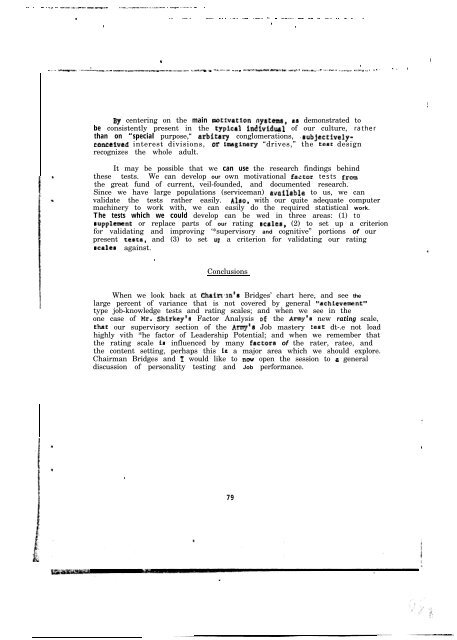Technical Report - International Military Testing Association
Technical Report - International Military Testing Association
Technical Report - International Military Testing Association
Create successful ePaper yourself
Turn your PDF publications into a flip-book with our unique Google optimized e-Paper software.
_ . - . .._ - -_-..-.-- _-_- ._,__X_____.___r_C_ _ --_ .._.-.. - .<br />
- _ __ .-_. - _ -~. .__ ..__ .-_ -. - _____. - _- _ _. .- _ _ _<br />
.<br />
. .<br />
.<br />
_.- ---....-I- --...- -~..-.‘---.------.-. C....‘~e-.C.---F --*- -..s.*---1m-*r~- --...-,.. -..ea.,I .,,_.__. _.‘_,” ,_ I ,, ..<br />
By centering on the main mtfvvation nyetenm, ns demonstrated to<br />
be consistently present in the typlcal indFvFdua1 of our culture, rather<br />
than on “special purpose,“ arbitary conglomerations, .eubJectivelyconceivad<br />
interest divisions, or iamginary “drives,” the test design<br />
recognizes the whole adult.<br />
It may be possible that we can use the research findings behind<br />
these tests. We can develop our own motivational fastor tests from<br />
the great fund of current, veil-founded, and documented research.<br />
Since we have large populations (serviceman) avaiiable to us, we can<br />
validate the tests rather easily. ~160, with our quite adequate computer<br />
machinery to work with, we can easily do the required statistical work.<br />
The tests which we could develop can be wed in three areas: (1) to<br />
rupplement or replace parts of our rating wales, (2) to set up a criterion<br />
for validating and improving ‘*supervisory and cognitive” portions of our<br />
present teata, and (3) to set UP a criterion for validating our rating<br />
rcales against.<br />
.<br />
Conclusions<br />
When we look back at Chain.ln’s Bridges’ chart here, and see the<br />
large percent of variance that is not covered by general *‘achfevewnt”<br />
type job-knowledge tests and rating scales; and when we see in the<br />
one case of Mr. Shirkey’s Factor Analysis of, the Army’s new rating scale,<br />
that our supervisory section of the Army’s Job mastery test dt-.e not load<br />
highly vith *he factor of Leadership Potential; and when we remember that<br />
the rating scale is influenced by many factora of the rater, ratee, and<br />
the content setting, perhaps this ic a major area which we should explore.<br />
Chairman Bridges and I would like to nou open the session to a general<br />
discussion of personality testing and Job performance.<br />
.<br />
79<br />
.<br />
” *<br />
.<br />
!<br />
I<br />
I<br />
I









